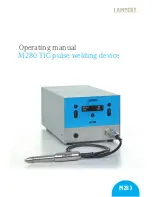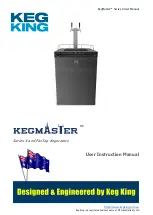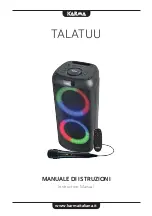
In MANUAL MODE (“PRG 0”), once the wire feed rate and arc voltage parameters have
been selected correctly (i.e. with compatible values), the selected value of the
reactance is immaterial.
6.1.3 PULSE ARC TRANSFER MODE
This is a “controlled” transfer situated in the “spray arc” transfer area (modified spray
arc) and therefore has the advantages of speedy melting and lack of projections,
extending to significantly low current values so as to satisfy many typical “short arc”
applications as well.
Every current impulse corresponds to the separation of a single drop from the wire
electrode; the phenomenon occurs with a frequency that is proportional to the wire feed
rate with the variation rule related to the type and diameter of the wire itself (typical
frequency values: 30-300Hz).
ing voltage range :
17-28V
-
suitable gases :
Normally the contact pipe should be 5-10mm inside the nozzle, the higher the arc
voltage, the further inside; the length of free wire (stick-out) will normally be between 10
and 12mm.
Application
: “horizontal” welding on medium-low thicknesses and on heat-sensitive
materials,
particularly suitable for welding light alloys (aluminium and its alloys)
also on thicknesses below 3mm
.
6.1.4 ADJUSTING THE WELDING PARAMETERS IN MIG/MAG
6.1.4.1 Protective gas
The gas flow rate should be:
short arc:
8-14 l/min
spray arc and pulse arc:
12-20 l/min
depending on welding current intensity and nozzle diameter.
6.1.4.2 Welding current
Welding current is adjusted by the operator by turning the encoder knob
(FIG.E (14))
.
When SPRAY/SHORT ARC is selected, each turn of the encoder knob
(14)
corresponds to a wire feed rate adjustment (m/minute), which is shown on the display
(16)
; during welding, the display automatically switches to the actual current value
(amps).
Indicative values for the current with the most commonly used wires are given in the
table
(TAB.5)
.
6.2 TIG WELDING (DC)
Application:
Horizontal welding with thicknesses of at least 3-4mm (very fluid pool);
After making the connections to the welding circuit as described in section 5.5.2
execution rate and deposit rate are very high (high heat transfer).
proceed as follows:
- Select the TIG welding procedure on the welding machine control panel
(FIG.D (6))
.
- Set the welding current to the desired value using the encoder knob
(5)
(the value can
always be adjusted during welding as well). If necessary insert the current downslope
using the potentiometer
(8)
(brief indication on the display
(4)
).
Arc strike is by contact; welding start and stop is controlled by the torch button, post gas
time is automatic, proportional to welding current.
The table
(TAB.6)
gives a summary of indicative data for welding stainless steel or
hard alloys
6.3 MMA WELDING WITH COATED ELECTRODES
After making the welding circuit connections as described in parag. 5.5.3 it is necessary
Carbon and mild steels
to select the MMA procedure:
- Suitable wire diameter:
0.8-1.6mm
-
if connected to the welding machine
, using the appropriate button
(FIG.D (6))
.
-
Welding current range:
60-360A
The welding current should be adjusted to the desired value using the encoder knob
-
Arc voltage range :
18-32V
(5)
and any “ARC FORCE” dynamic overcurrent can be varied between 0 and 100%
-
Suitable gases :
mix Ar/CO , Ar/CO /O (Co max 20%)
using the encoder knob
(13)
(brief indication on the display
(4)
).
2
2
2
2
Stainless steels
-
if connected to the wire feeder
, using the appropriate button
(FIG.E (7))
. The
- Suitable wire diameter:
0.8-1.2mm
welding current should be adjusted to the desired value using the encoder knob
(14)
;
-
Welding current range:
50-230A
any “ARC FORCE” dynamic overcurrent can be varied between 0 and 100% using
-
Welding voltage range :
17-26V
the encoder knob
(13)
(brief indication on the display
(15)
).
-
Suitable gases :
mix Ar/O , Ar/CO (1-2%)
2
2
The table
(TAB.7)
summarises some indicative data for current in relation to
Aluminium and alloys
electrode diameter.
- Suitable wire diameter:
0.8-1.6mm
6.4 Weld quality
-
Welding current range:
40-320A
The quality of the weld seam is higher when less spatter is produced. this is determined
-
weld
principally by a correct balance of the welding parameters: current (wire speed), wire
Ar 99.9%
diameter, arc voltage etc...
The weld speed (i.e. the advancement speed
along the joint) is also a determining factor for the correct execution of the seam. This is
particularly important for good penetration and correct shape of the seam.
The most common welding flaws are summarized in
( TAB.8)
.
7. MAINTENANCE
_____________________________________________________________________________________________________________________
WARNING! BEFORE CARRYING OUT MAINTENANCE OPERATIONS MAKE
SURE THE WELDING MACHINE IS SWITCHED OFF AND DISCONNECTED FROM
THE MAIN POWER SUPPLY.
_____________________________________________________________________________________________________________________
7.1 ROUTINE MAINTENANCE
ROUTINE MAINTENANCE OPERATIONS CAN BE CARRIED OUT BY THE
OPERATOR.
7.1.1.Torch
- Do not put the torch or its cable on hot pieces; this would cause the insulating
materials to melt, making the torch unusable after a very short time.
- Make regular checks on the gas pipe and connector seals.
- Every time the wire reel is changed, blow out the wire-guide hose using dry
When PULSE ARC or
PULSE ARC PULSE-ON-PULSE
is selected, each time the
compressed air (max. 5bar) to make sure it is not damaged.
encoder knob
(14)
is turned this corresponds to an adjustment of welding current, which
- At least once a day, check the wear and correct assembly of the parts at the end of
is shown on the display
(16)
; during welding, the display automatically switches to the
the torch: nozzle, contact tip, gas diffuser.
actual current value.
In both modes it is possible to press key (17) to pass to regulation of thickness in mm
7.1.2 Wire feeder
(LED (16b) lit up) using the encoder (14). The machine automatically calculates the
- Make frequent checks on the state of wear of the wire feeder rollers, regularly
current required to weld this thickness. Also in this case the display will switch to the
remove the metal dust deposited in the feeder area (rollers and wire-guide infeed
actual current (amps.) during welding.
and outfeed).
It should be pointed out that in all the synergic programs the maximum and minimum
values for the settings (m/minute, amps or thickness in mm) are programmed in the
7.2 EXTRAORDINARY MAINTENANCE
factory and cannot be changed by the user.
EXTRAORDINARY MAINTENANCE OPERATIONS SHOULD BE CARRIED OUT
ONLY AND EXCLUSIVELY BY SKILLED OR AUTHORISED ELECTRICAL-
MECHANICAL TECHNICIANS.
_____________________________________________________________________________________________________________________
6.1.4.3 Arc voltage and arc pinch-off
In the MIG/MAG pulse-arc and pulse-on-pulse synergic programmes these two
WARNING! BEFORE REMOVING THE WELDING MACHINE PANELS AND
parameters determine the arc size
during welding.
Arc voltage indicates the distance of the wire from the piece, the operator is allowed to
WORKING INSIDE THE MACHINE MAKE SURE THE WELDING MACHINE IS
make a simple correction between -5% and +5% of the preset voltage value in each
SWITCHED OFF AND DISCONNECTED FROM THE MAIN POWER SUPPLY
programme, if it is necessary to adjust the actual arc length under specific
OUTLET.
_____________________________________________________________________________________________________________________
circumstances. The higher the value the further the wire from the piece.
Arc pinch-off, on the other hand, determines arc concentration or amplitude. The
If checks are made inside the welding machine while it is live, this may cause
adjustment range for this parameter is from -10% to +10% of the default value for the
serious electric shock due to direct contact with live parts and/or injury due to
programme. The higher the value the more concentrated will be the arc.
direct contact with moving parts.
- Inspect the welding machine regularly, with a frequency depending on use and the
In manual programming "PRG 0" arc voltage is defined by setting a suitable value for the
dustiness of the environment, and remove the dust deposited on the transformer,
selected wire feed rate, according to the following relationship:
reactance and rectifier using a jet of dry compressed air (max. 10bar).
U2 = ( 14+0.05 I2 ) where:
- Do not direct the jet of compressed air on the electronic boards; these can be
-U2 = Arc voltage in volts
cleaned with a very soft brush or suitable solvents.
-I2 = Welding current in amps.
- At the same time make sure the electrical connections are tight and check the wiring
Bear in mind that the selected loadless voltage will correspond to a voltage under load
for damage to the insulation.
(during welding) that is 2-4V lower.
- At the end of these operations re-assemble the panels of the welding machine and
screw the fastening screws right down.
- Never, ever carry out welding operations while the welding machine is open.
8. TROUBLESHOOTING
(TAB.9)
_____________________________________________________________________________________________________________________
WARNING! CARRYING OUT CERTAIN CHECKS IMPLIES THE RISK OF
CONTACT WITH LIVE AND/OR MOVING PARTS.
_____________________________________________________________________________________________________________________
Before carrying out any operation on the wire feeder or inside the welding machine it is
absolutely necessary to refer to section 7
“ MAINTENANCE”.
the two levels and times are set correctly it is possible to obtain a "rippled bead" weld
that strongly resembles TIG welding.
Likewise, the torch position should be adjusted as shown in
fig. O
to prevent excessive
spray production and flaws in the seam.
6.1.5 BI-LEVEL AND PULSE ON PULSE OPERATION
The bi-level operation setting is made using key (8) and can be selected in MIG/MAG
pulse arc and short arc modes. The welding cycle starts by pressing and releasing the
torch button (as for 4-stroke), the initial working point for the welding machine is the
main welding level (LED (10a)), the machine displays the current and voltage for this
working point. If the torch button is pressed for less than 0.5 seconds the machine will
change the working point from the main level to the secondary level (LED 10(b)), and
will display the current and voltage of the secondary level. Every time the button is
pressed the machine will continue to pass from one level to the other until the button is
pressed for more than 0.5 seconds, Even though the machine displays the
instantaneous value of current and voltage during welding, it is only possible to change
the current and voltage of the main welding level.
MIG/MAG Pulse on Pulse operation is activated by key (7) with the MIG/MAG Pulse arc
LED. This mode is a special type of bi-level because also in this case two working points
can be set with the same criteria as bi-level (LED's (10a) and (10b)). It is possible to set
the time in each level, t1 and t2 (LED's (10c) and (10d)) and they are not decided
manually as for bi-level. During welding the machine therefore automatically continues
to change the working point from the main level (time t1) to the secondary level (time t2).
This leads to the creation of a pulse within the pulse, from which the name is derived. If
- 9 -










































